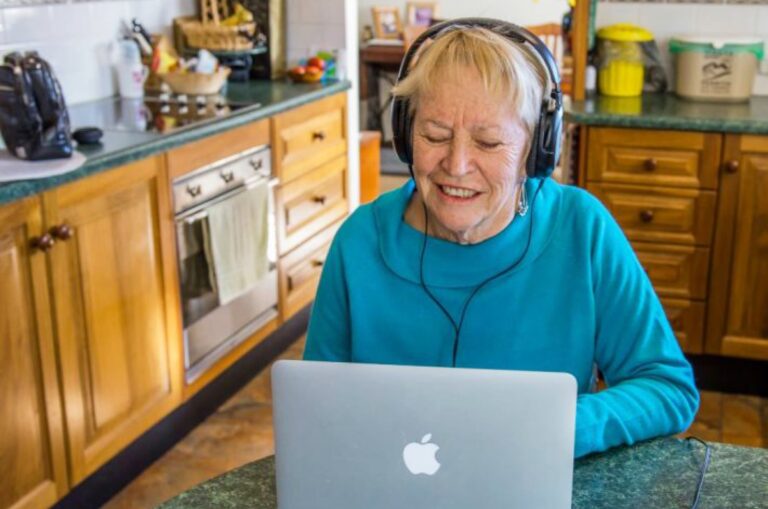Intro to Assistive Tech for Students
Student learning can be tough for everyone. Luckily, if you’re a student with partial vision, blindness or other disabilities, there are a wide range of assistive technology tools and devices that enable you to reach—and exceed—your academic potential.
Whether you’re preparing for uni or preparing your child for their first day at school, assistive technologies offer valuable support for students of all ages and abilities. There are many different software programs and electronic devices designed to support the best possible learning experience for people with partial vision and blindness. With so many high-tech options, it can get overwhelming. Which assistive device is most helpful for a student with blindness? What’s the most common assistive technology for people with partial vision?
In this article, we’ll showcase some of the more common devices and how they can be used in general education. Remember though, the best assistive technology will depend on your unique preferences, abilities, and requirements. This should be used as a guide only: if you need more specific and personally tailored information, give us a call on 1800 484 333. You can also learn more about our assistive technology training service. In the meantime, let’s check out some of the most popular options for students with partial vision or blindness.
Screen readers.
Examples include:
Screen readers are assistive technology tools that convert digital text into synthesised audio of a person reading text aloud. Screen readers are versatile tools for both teaching and learning, with a wide range of uses, features and functions. They’re particularly helpful for students who need to:
— Read websites. Screen readers can interpret the code and HTML structure of web pages, and support students to quickly identify information about headings, website links, buttons, and other website elements. This ensures students can browse the web and easily engage with any online learning management systems or course materials.
— Read documents. Screen readers can access and read a range of document formats, including text documents, PDFs and e-books.
— Read and write emails. Screen readers support students to read and write emails by reading the content aloud. They can also provide feedback and analysis on the text that is written in reply to the original email.
— Accessing software programs and other tools. Like with browsing websites on the internet, screen readers can make different software applications more accessible to students with disability. The screen reader can identify different aspects of a program’s user interface and providing spoken feedback and guidance to support people to use the program.
Text-to-speech software.
Examples include:
Text-to-speech software (also commonly referred to as TTS) offers some similar functionality to a screen-reader, but typically serves a range of different and distinct purposes for students with disability. While screen readers are comprehensive and high-tech devices that can read code, identify elements of websites and software programs, and more, text-to-speech software is usually used for:
— Proofreading lecture notes or essays
— Listening to lecture notes
— Reviewing and self-editing written work. By hearing your own content read aloud, students can better identify grammatical errors, fix any sentence structure issues, and improve overall confidence with writing.
— Participating in online discussions. Text-to-speech supports students with partial vision or blindness to read posts and comments in student forums or chat-based programs.
— Reducing eye strain and maintaining progress with studying efforts. Students with partial vision or blindness often experience eye strain when reading for extended periods. Text-to-speech provides an alternative and less intensive method for accessing content, reducing strain and enabling ongoing study for long periods of time.
Word prediction software.
Examples include:
— WordQ
You might be familiar with this type of assistive technology from using certain smartphones. Word prediction software is designed to improve typing and writing efficiency by predicting and suggesting common words that may feature next as students type. This reduces the need for extensive manual typing and can reduce the visual strain associated with searching for the right letter keys on keyboards or keypads. It is an effective technology to support students in:
— Reducing typos and spelling errors.
— Enhancing writing speed. With the support of word prediction software, students can be more efficient and productive as they select from suggested words rather than manually typing out entire words or phrases.
— Promoting more independent writing. Instead of focusing intently on typing, choosing from a range of suggested words allows students with partial vision or blindness to focus on the overall content and messaging of what they write.
— Assisting with more efficient note taking. Word prediction allows students to write notes faster and more efficiently when following along with a lecturer’s notes, ensuring they don’t miss any important ideas or concepts.
— Reducing writing fatigue. By streamlining the process associated with creating content, word prediction software can reduce the strain and fatigue associated with extensive manual writing sessions.
Speech-to-text software.
Examples include:
Speech-to-text software (STT) is also known as voice recognition or dictation software. While it’s not specifically designed as an assistive technology for students with disability, the functionality of STT means it can be a useful support for people who have difficulty with typing or other text input methods. If you’re a student with partial vision or blindness, it’s important to consider software programs with enhanced accessibility features and a user-friendly interface.
Speech-to-text can be useful for:
— Writing and completing assignments. Students can verbally express their ideas, making it faster and easier to complete written tasks.
— Dictating research or lecturer’s notes. Speaking observations aloud rather than writing them can streamline the process of compiling notes and reduce the fatigue associated with manual creation.
— Participating in online discussions. Many courses use forums or learning management systems to facilitate student engagement. Speech-to-text can be a valuable support in enabling students to contribute easily and efficiently.
— Reducing writing fatigue.
Braille displays and braille notetakers.
Examples include:
— Refreshable braille displays like Focus
Braille notetakers feature a refreshable braille display. This typically consists of a small row of dynamic braille cells featuring six or eight dots. These cells change dynamically to represent different braille characters and convey written content to students with partial vision or blindness. Braille notetakers can be used to:
— Participate in virtual meetings and classes. Some braille notetakers support virtual meeting applications, allowing students to participate in online discussions and read shared documents using braille.
— Manage calculations and mathematics. Many braille notetakers include calculators and features for working with equations.
— Display content from other devices. Braille notetakers can connect with computers, smartphones and other electronic devices, enabling students to read material in braille.
Keyboard alternatives.
There are many alternatives to traditional keyboards that are designed to better support students with partial vision, blindness, and other disabilities. These include:
— Large print keyboards with high contrast keys and easy to read print. Some keyboards feature different colour coding for each section of the keyboard (like numbers and function keys in comparison to letters), and large bold letters.
— Tactile keyboards with distinctive shapes or textures to guide students to different sections of the keyboard based on physical touch.
— Adaptive keyboards are designed with flexibility in mind, so that students with disabilities can customise different features and behaviours to meet specific needs or preferences. For example, you can program different keys to initiate different commands, adjust the layout of where certain keys are located on the board, and alter the sensitivity to better align with different typing styles.
Ready to learn more?
If you’re ready to have a chat about the best assistive technology tools for you or your child, you can:
— Give us a call today on 1800 484 333
— Get in touch using our request a service form
— Read more about our assistive technology training service
Find out more
Ready to continue?
Seems like you have filled this form earlier. Let’s pick up where you left off.



